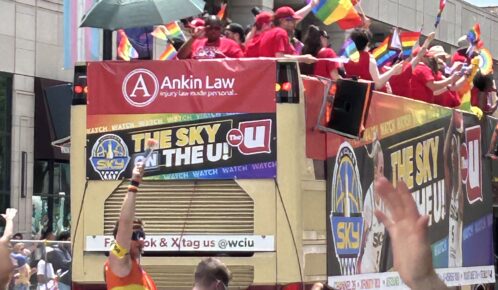What was the civil rights movement? The civil rights movement was a social campaign that entailed fighting for equality and justice for African-American citizens in the 1950s through the 1960s, with the aim of ending segregation under Jim Crow laws and giving all Americans equal rights.
Table of Contents

Over the years, the civil rights movement has continued in various forms, as minorities and marginalized groups seek equality and equity. As a result of this movement’s momentum, Illinois has also seen many changes in the push for equal rights.
What Is the Historical Background of the Civil Rights Movement in Illinois?
The civil rights movement in Illinois goes back to the 1800s.
In 1800, to be exact, Illinois implemented the “Black Code” when the state became part of the Indiana Territory. This code essentially kept African Americans enslaved by allowing them to work as “indentured servants” for a specific period of time in exchange for food and shelter.
By 1865, after the Civil War ended, Illinois officially repealed the “Black Code,” putting an end to slavery. The Illinois Civil Rights Act of 1885 then came along to prevent discrimination in public locations, including restaurants, hotels, and theaters.
Another notable period in Illinois’s civil rights involvement came in 1965, which saw the introduction of the Chicago Freedom Movement, also known as the Chicago open house movement. By 1966, this movement would successfully allow African-Americans to gain access to the same services as other Americans, including open housing and healthcare. This movement would eventually lead to the Fair Housing Act of 1968, further helping African Americans attain equality.
While there have been many advancements in the civil rights movement in Illinois, racism and discrimination remain serious issues in the state.
Racial Tensions and Discrimination Prevalent in Illinois
Illinois has seen much racial prejudice and discrimination over the years, and it continues today.
One of the most notable events in this state included the Chicago Race Riot of 1919, which was the most serious of the multiple race riots that occurred in the U.S. after World War I. The riot began when a young African-American boy drowned in Lake Michigan after venturing to a segregated beach designated for white people. While swimming in the lake, beach goers began to stone the youth, causing his death.
This event, coupled with general racial tension in Chicago’s South Side, culminated in the Chicago Race Riot.
Today, racial discrimination continues, with some instances involving police brutality, and a recent report concluded that Illinois is the worst state in the U.S. for racial financial equality.
Early Activism and Organizing Efforts
While racism and discrimination have been in Illinois for many years, some activists have made an effort to bring about change across the state.
One organizing effort entailed the creation of the Congress of Racial Equality, which James Farmer and other activists developed in 1942 with inspiration from Gandhi and his approach to protests. Members of this group would stage sit-ins in recreational centers and restaurants in the city, along with other nonviolent protests.
In the years since, this and other organized efforts have helped reduce discrimination and racial tension in not just Illinois, but across the country.
Major Milestones and Events
Over the decades, the civil rights movement has had some significant successes.
Legislative Changes and Legal Battles
Years after slavery ended, African Americans in the U.S. still faced racism and experienced segregation due to Jim Crow laws that came from the South. However, by the 1960s, the civil rights movement took off and resulted in a few key wins for activists.
You might wonder, “What is a civil lawsuit involving civil rights?” One success was the Brown decision in 1954, which resulted from the Brown v. Board of Education case, in which the court determined that separate segregated schools led to inequality.
The next notable piece of legislation pushing against discrimination in the nation was the Civil Rights Act of 1964, which President John F. Kennedy helped start in 1963. Following Kennedy’s assassination the same year, President Lyndon Johnson continued pushing for civil rights, eventually leading to the introduction of the Civil Rights Act of 1964. This act specifically prevented discrimination against people on the basis of color, race, religion, and other characteristics.
The next year, in 1965, the Voting Rights Act of 1965 came about to give African Americans more freedom in the South. Prior to this act, states could attempt to block African-American votes by forcing them to take literacy tests and complete other types of tests that they might have failed. The result of this act was a huge surge in African-American voters in southern states.
These are some of the biggest events that changed legislation and behavior in this country.
Key Figures in the Civil Rights Movement
Over the years, there have been many prominent figures in the civil rights movement.
The following are some of the most well-known and reputable leaders from this movement:
- Martin Luther King, Jr. — This figure was a minister, activist, and political dissident who contributed significantly to the civil rights movement and the Civil Rights Act of 1964.
- Malcolm X — This individual was another notable leader who complemented MLK’s work as a civil rights activist and minister.
- Daisy Bates — This figure was a civil rights activist who worked as a journalist, a speaker during the March on Washington, and a mentor for the Little Rock Nine, which comprised nine African-American students who attended the predominantly white Little Rock Central High School in 1957.
- Claudette Colvin and Rosa Parks — While most people know Rosa Parks as the girl who refused to sit in the back of a bus in protest against racial discrimination, Claudette Colvin was the first to engage in a similar protest. In 1955, at the age of 15, the police arrested Claudette for refusing to give her seat up to a white woman on a bus in Montgomery, Alabama.
- Thurgood Marshall — This individual was a civil rights lawyer who worked from 1967 to 1991 as an associate justice of the U.S. Supreme Court, and he was the first African-American Supreme Court justice. Marshall anticipated that the Brown decision that ruled segregated schools unequal would lead to a complete dissolution of segregated schools by the 1960s.
These are simply some of the many figures who have paved the way for equality among American citizens.
Legacy of the Civil Rights Movement in Illinois
The civil rights movement has a storied history in Illinois as much as it does all over the country, with most civil rights activism occurring in Chicago.
What Are Some Changes Brought About by the Civil Rights Movement?
In addition to the Chicago Freedom Movement and the Fair Housing Act of 1968, Illinois would see some significant civil rights developments up to today.
One considerable development was the Illinois Human Rights Act, which came into being in 1979 and put specific processes and laws into place to protect all individuals in Illinois from discrimination while providing them with equal opportunities.
Challenges in Achieving Full Racial Equality in Present-Day Illinois
Although progress has helped eliminate much racism and discrimination in the U.S., including Illinois, racial discrimination still occurs today.
There are several ways racism still impacts minorities in Illinois. One of these is systemic racism, also known as institutional racism. This type of racism entails deeply embedded practices and policies of a racist nature that lead to unequal treatment of individuals on the basis of race. This type of racism would require a complete restructuring of the justice system and other institutions that have a long history of racism behind their development.
Another type of racism that affects individuals today is racial disparity in policing. People expect police forces in Illinois to protect and serve them, but instances of police brutality still occur, many of which disproportionately impact people of color. Part of this racial disparity is the result of the aforementioned systemic racism, which has led to bias among police forces. With the militarization of police officers along with inadequate training,
Stemming from the concept of systemic racism and racial disparity, you might ask, “What is a Section 1983 lawsuit?” This is a specific type of lawsuit that individuals might file against law enforcement officers who engage in brutality or other forms of discrimination in violation of civil rights. Instances when you might file a Section 1983 lawsuit include false arrest or imprisonment, excessive use of force, failure to intervene, or malicious prosecution.
If you believe that you are the victim of civil rights violations from the police or another party, you may be able to build a case with the help of a civil rights lawyer. Knowing more about the civil rights movement and what it was about could help you determine whether someone has violated your rights.



